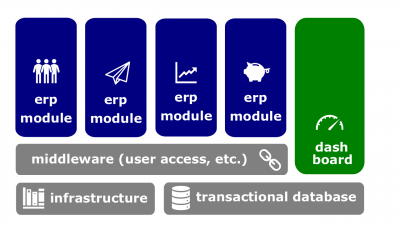Difference between revisions of "Enterprise resource planning ecosystem"
| Line 7: | Line 7: | ||
*[[Transactional database]]. Any [[database]] that is able to accommodate transactions related to the conducting of business, especially buying or selling. | *[[Transactional database]]. Any [[database]] that is able to accommodate transactions related to the conducting of business, especially buying or selling. | ||
*[[Management dashboard]]. The panel containing instruments and controls that a software user is able to utilize. | *[[Management dashboard]]. The panel containing instruments and controls that a software user is able to utilize. | ||
| − | *[[ERP module]]. A module of [[ | + | *[[ERP module]]. A module of an [[enterprise resource planning ecosystem]]. |
==Related concepts== | ==Related concepts== | ||
Revision as of 20:55, 16 February 2020
An enterprise resource planning ecosystem (alternatively known as enterprise resource planning system, ERP system, ERP systems, and ERP suite; hereinafter, the Ecosystem) is any system of systems, also known as ERP modules, that are designed to facilitate enterprise resource planning (ERP).
The Ecosystems are designed to seamlessly integrate business processes throughout the entire enterprise usually in realtime. ERP software commonly powers this integration.
Components
- Transactional database. Any database that is able to accommodate transactions related to the conducting of business, especially buying or selling.
- Management dashboard. The panel containing instruments and controls that a software user is able to utilize.
- ERP module. A module of an enterprise resource planning ecosystem.
Related concepts
- Enterprise middleware. Middleware that provides all software applications with data and/or services.
